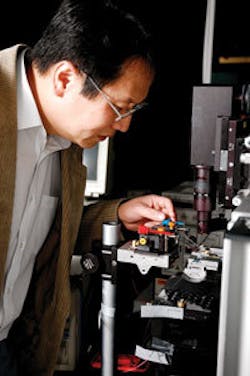Photonic crystals enable electro-optical modulator in silicon
In an invited talk given on Jan. 25 at the International Society for Optical Engineering (SPIE) Photonics West conference (San Jose, CA; Jan. 21-26), Ray Chen, a professor of electrical engineering at the University of Texas at Austin, described an ultracompact silicon-photonic-crystal electro-optic modulator that was designed, fabricated, and demonstrated by his group. The 80-mm-long waveguide has a Mach-Zehnder interferometer structure and was able to function while being an order of magnitude shorter than conventional silicon optical modulators because of the light-slowing effect of the photonic crystals. With a driving current across the active region on the order of 0.15 mA, less than 3 mW of power was needed for light modulation
“We were able to get the new silicon modulator to control the transmission of laser light while using ten times less power than normally needed for silicon modulators,” Chen said. Once silicon optical modulators are combined with lasers on a silicon platform, they could become the mainstay of consumer electronic devices, telecommunications systems, biosensors, and other devices. In computers they could significantly enhance interconnection speeds and efficiencies. “In a Pentium 4, more than 50% of the computer’s power is consumed by interconnection,” Chen said. Contact Ray Chen at [email protected].

